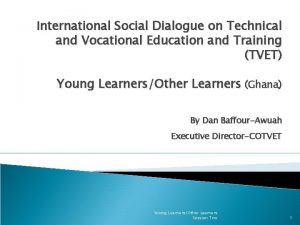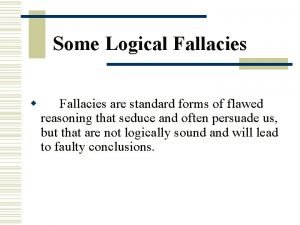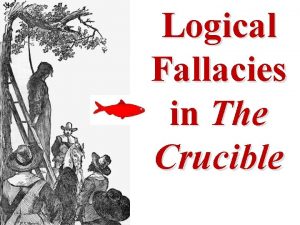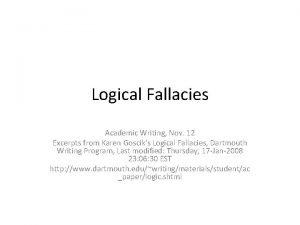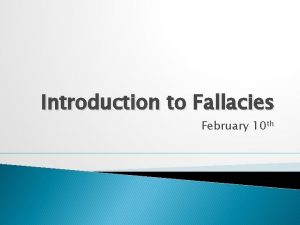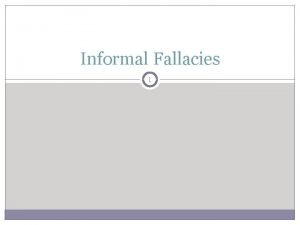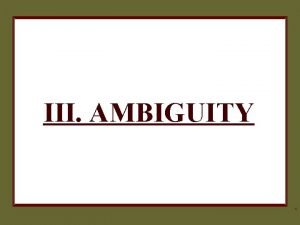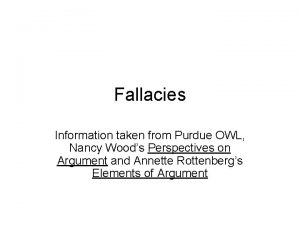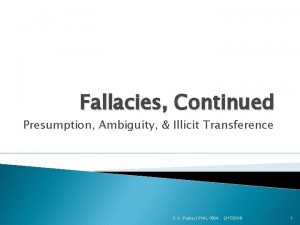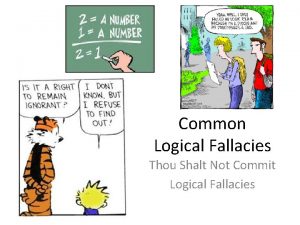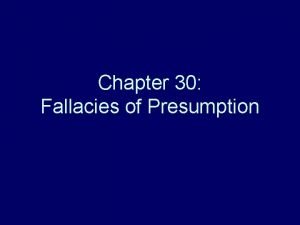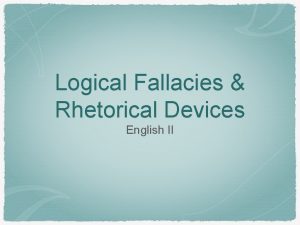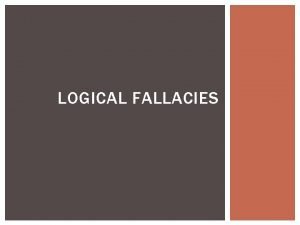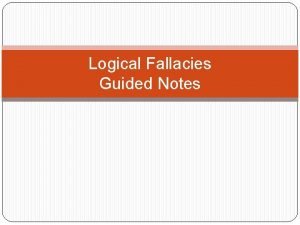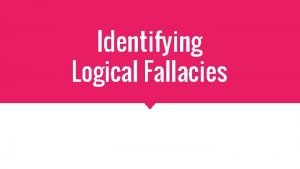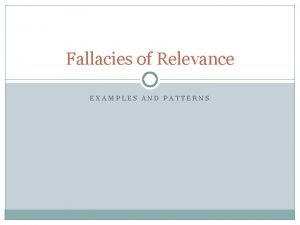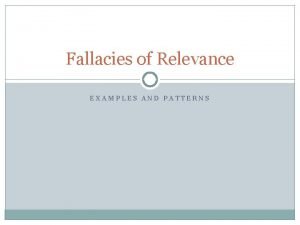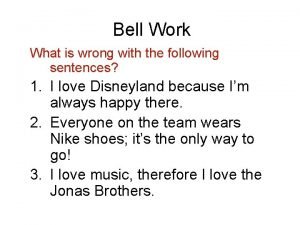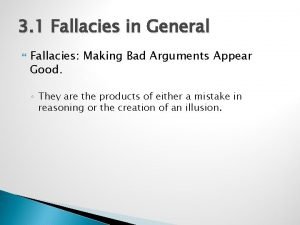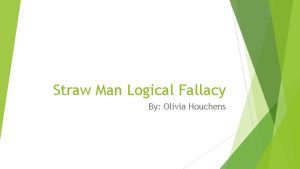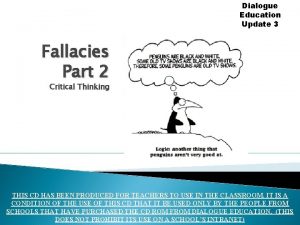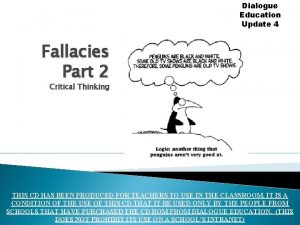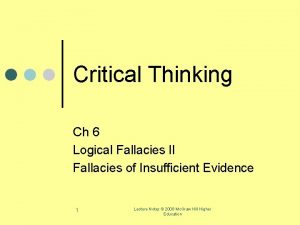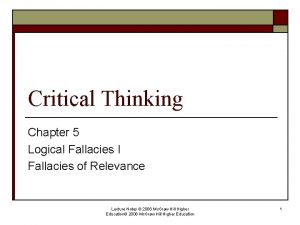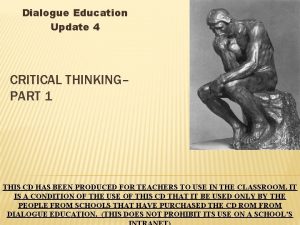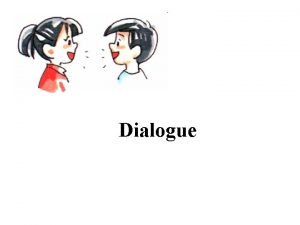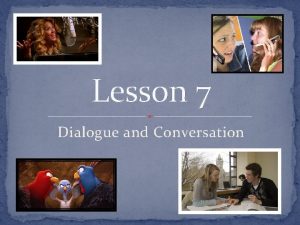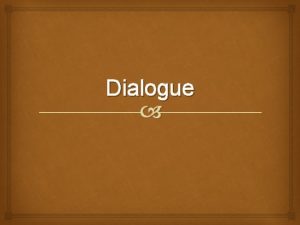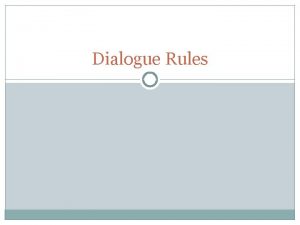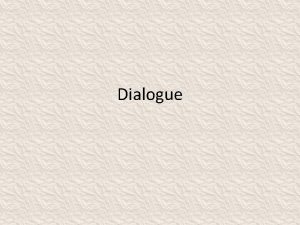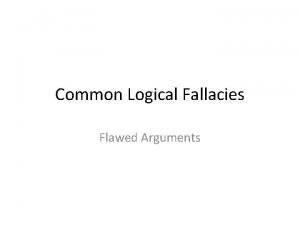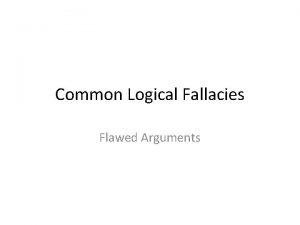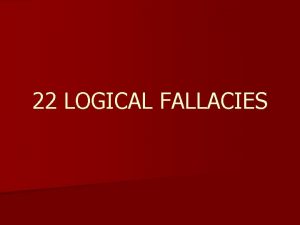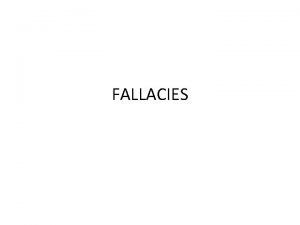Dialogue Education Update 3 Fallacies Part 1 Critical

































- Slides: 33

Dialogue Education Update 3 Fallacies Part 1 Critical Thinking THIS CD HAS BEEN PRODUCED FOR TEACHERS TO USE IN THE CLASSROOM. IT IS A CONDITION OF THE USE OF THIS CD THAT IT BE USED ONLY BY THE PEOPLE FROM SCHOOLS THAT HAVE PURCHASED THE CD ROM FROM DIALOGUE EDUCATION. (THIS DOES NOT PROHIBIT ITS USE ON A SCHOOL’S INTRANET). 1

Contents Page 3 – Definition of a Fallacy Page 4 - Video Introduction to Fallacies Pages 5 to 11 - Informal and Formal Fallacy Pages 12 to 19 - Material Fallacies Pages 20 to 23 - Verbal Fallacies Pages 24 - Introduction to Fallacies Pages 25 – Ad Hominem Page 26 – Irrelevant Authority Page 27 – Genetic Fallacy Page 28 – Hasty Generalisation Page 29 – Argument from Ignorance Page 30 – Equivocation Pages 31 to 32 – Affirming the Consequent Page 32 - Denying the Antecedent Page 33 - Bibliography 2

Fallacies A fallacy is a component of an argument which, being demonstrably flawed in its logic or form, renders the whole argument invalid (except in the case of 'begging the question' fallacy). 3

YOUTUBE Video on fallacies-An introduction to Fallacies Click on the image to the left. You will need to be connected to the internet to view this presentation. Enlarge to full screen 4

Fallacies In logical arguments, fallacies are either formal or informal. 5

Fallacies There are fallacies of relevance, fallacies involving causal reasoning, and fallacies resulting from ambiguities (or equivocations) 6

Fallacies Recognizing fallacies in actual arguments may be difficult since arguments are often structured using rhetorical patterns that obscure the logical connections between assertions. 7

A different approach to understanding and classifying fallacies is provided by argumentation theory. 8

Fallacious arguments involve not only formal logic but also causality. 9

Note that providing a critique of an argument has no relation to the truth of the conclusion. The conclusion could very well be true, while the argument as to why the conclusion is true is not valid. 10

Fallacies Note that providing a critique of an argument has no relation to the truth of the conclusion. The conclusion could very well be true, while the argument as to why the conclusion is true is not valid. 11

Formal Fallacies Affirming the Consequent-draws a conclusion from premises that do not support that conclusion by assuming Q implies P on the basis that P implies Q. 12

Formal Falacies Denying the antecedent-draws a conclusion from premises that do not support that conclusion by assuming Not P implies Not Q on the basis that P implies Q 13

Begging the question (also called Petitio Principii, Circulus in Probando-arguing in a circle, or assuming the answer)-demonstrates a conclusion by means of premises that assume that conclusion. 14

Fallacy of Accident (also called destroying the exception or a dicto simpliciter ad dictum secundum quid)--makes a generalization that disregards exceptions. 15

Converse Fallacy of Accident (also called reverse accident, destroying the exception, or a dicto secundum quid ad dictum simpliciter)--argues from a special case to a general rule (e. g. , Every swan I have seen is white, so it must be true that all swans are white. ) 16

Irrelevant Conclusion (also called Ignoratio Elenchi)--diverts attention away from a fact in dispute rather than address it directly. This is sometimes referred to as a "red herring". Subsets include: ◦ purely personal considerations (argumentum ad hominem), popular sentiment (argumentum ad populum--appeal to the majority), fear (argumentum ad baculum), conventional propriety (argumentum ad verecundiam--appeal to authority) 17

of False Cause or Non Sequitur (Latin for "it does not follow")--incorrectly assumes one thing is the cause of another (e. g. , Our nation will prevail because God is great. ) Fallacy 18

Fallacy of Many Questions (Plurium Interrogationum)--groups more than one question in the form of a single question (e. g. , Is it true that you no longer beat your wife? A yes or no answer will still be an admission of guilt to wife-beating. ) 19

Equivocation consists in employing the same word in two or more senses, e. g. in a syllogism, the middle term being used in one sense in the major and another in the minor premise, so that in fact there are four not three terms ("All heavy things have a great mass; this is heavy fog; therefore this fog has a great mass. ") 20

Amphibology is the result of ambiguity of grammatical structure, e. g. of the position of the adverb "only" in careless writers ("He only said that, " in which sentence, the adverb has been intended to qualify any one of the other three words). 21

Fallacy of Composition "From Each to All". Arguing from some property of constituent parts, to the conclusion that the composite item has that property e. g. "all the band members (constituent parts) are highly skilled, therefore the band (composite item) is highly skilled". 22

Proof by verbosity, sometimes colloquially referred to as argumentum verbosium - a rhetorical technique that tries to persuade by overwhelming those considering an argument with such a volume of material that the argument sounds plausible, superficially appears to be well-researched, and it is so laborious to untangle and check supporting facts that the argument might be allowed to slide by unchallenged. 23

Informal Fallacies In logical arguments, fallacies are either formal or informal. Because the validity of a deductive argument depends on its form, a formal fallacy is a deductive argument that has an invalid form, whereas an informal fallacy is any other invalid mode of reasoning whose flaw is not in the form of the argument. 24

Personal Attack/Ad Hominem Personal Attack When an arguer rejects a person’s argument or claim by attacking the person’s character rather than examining the worth of the argument or claim itself. Example: Professor Doogie has argued for more emphasis on music in our F 2 F classes to facilitate creativity. But Doogie is a selfish bigheaded fool. I absolutely refuse to listen to him. Pattern 1. X is a bad person. 2. Therefore X's argument must be bad. 25

Argument from an Irrelevent Authority Citing a witness or authority that is untrustworthy. Example: My dentist told me that aliens built the lost city of Atlantis. So, it’s reasonable to believe that aliens did build the lost city of Atlantis. Authority Assessment Tips 1. 2. 3. 4. 5. 6. 7. 8. Is the source an authority on the subject at issue? Is the source biased? Is the accuracy of the source observations questionable? Is the source known to be generally unreliable? Has the source been cited correctly? Does the source’s claim conflict with expert opinion? Can the source’s claim be settled by an appeal to expert opinion? Is the claim highly improbable on its face? 26

Genetic Fallacy To attack the argument not in terms of its content but in terms of its origins. Example: All claims of the Freemasons can be safely ignored. The Freemasons are just an ancient trade union movement warmed up for modern times. Reason Arguing with – A is wrong because it has origins which Should be ignored. No reason is given.

Hasty Generalization Drawing a general conclusion from a sample that is biased or too small. Example: Norwegians are lazy. I have two friends who are from there, and both of them never prepare for class, or do their homework. Pattern 1. A biased sample is one that is not representative of the target population. 2. The target population is the group of people or things that the generalization is about. 28 3. Hasty generalizations can often lead to false stereotypes

Argument from Ignorance Claiming that something is true because no one has proven it false or vice versa. Example: Yoda must exist. No one has proved that he doesn’t exist. Agree I do! Remember “Not proven, therefore false” If such reasoning were allowed, we could prove almost 29 any conclusion.

Equivocation When an arguer uses a key word in an argument in two (or more) different senses. Example: In the summer of 1940, Londoners were bombed almost very night. To be bombed is to be intoxicated. Therefore, in the summer of 1940, Londoners were intoxicated almost every night. Remember Fallacies of Equivocation can be difficult to spot because they often appear valid, but they aren’t. 30

Formal Fallcies Affirming the Consequent and Denying the Antecedent Affirming the consequent Any argument that takes the following form is a non sequitur If A is true, then B is true. B is stated to be true. Therefore, A must be true. Even if the premises and conclusion are all true, the conclusion is not a necessary consequence of the premises. This sort of non sequitur is also called affirming the consequent. 31

Formal Fallacies Affirming the Consequent and Denying the Antecedent Denying the antecedent Another common non sequitur is this: If A is true, then B is true. A is stated to be false. Therefore B must be false. While the conclusion can indeed be false, this cannot be linked to the premise since the statement is a non sequitur. This is called denying the antecedent. 32

Bibliography Aristotle, On Sophistical Refutations, De Sophistici Elenchi. William of Ockham, Summa of Logic (ca. 1323) Part III. 4. John Buridan, Summulae de dialectica Book VII. Francis Bacon, the doctrine of the idols in Novum Organum Scientiarum , Aphorisms concerning The Interpretation of Nature and the Kingdom of Man, XXIIIff. The Art of Controversy | Die Kunst, Recht zu behalten - The Art Of Controversy (bilingual), by Arthur Schopenhauer (also known as "Schopenhauers 38 stratagems") John Stuart Mill, A System of Logic - Raciocinative and Inductive. Book 5, Chapter 7, Fallacies of Confusion. C. L. Hamblin, Fallacies. Methuen London, 1970. Fearnside, W. Ward and William B. Holther, Fallacy: The Counterfeit of Argument, 1959. Vincent F. Hendricks, Thought 2 Talk: A Crash Course in Reflection and Expression , New York: Automatic Press / VIP, 2005, ISBN 87 -991013 -7 -8 D. H. Fischer, Historians' Fallacies: Toward a Logic of Historical Thought, Harper Torchbooks, 1970. Douglas N. Walton, Informal logic: A handbook for critical argumentation. Cambridge University Press, 1989. F. H. van Eemeren and R. Grootendorst, Argumentation, Communication and Fallacies: A Pragma-Dialectical Perspective, Lawrence Erlbaum and Associates, 1992. Warburton Nigel, Thinking from A to Z , Routledge 1998. T. Edward Damer. Attacking Faulty Reasoning, 5 th Edition, Wadsworth, 2005. ISBN 0 -53460516 -8 Sagan, Carl, "The Demon-Haunted World: Science As a Candle in the Dark ". Ballantine Books, March 1997 ISBN 0 -345 -40946 -9. 480 pgs. 1996 hardback edition: Random House, ISBN 0394 -53512 -X, xv+457 pages plus addenda insert (some printings). Ch. 12. Wikipedia-Fallacies-http: //en. wikipedia. org/wiki/Fallacies Zaid Ali Allsagoff- Fallacies - http: //www. slideshare. net/zaid/fallacies-304448/ 33
 Critical semi critical and non critical instruments
Critical semi critical and non critical instruments Spaulding classification of medical devices ppt
Spaulding classification of medical devices ppt Is an alternative of log based recovery
Is an alternative of log based recovery Expressions of congratulation
Expressions of congratulation Compare non-critical readers with critical readers.
Compare non-critical readers with critical readers. Technical education dialogue
Technical education dialogue Technical education dialogue
Technical education dialogue Affirming the consequent fallacy
Affirming the consequent fallacy Fallacies in the crucible
Fallacies in the crucible Fallacies in academic writing
Fallacies in academic writing With good reason: an introduction to informal fallacies
With good reason: an introduction to informal fallacies Fallacies of relevance example
Fallacies of relevance example Amphiboly fallacy examples
Amphiboly fallacy examples Begging the question examples
Begging the question examples Ad populum fallacy
Ad populum fallacy Suppressed evidence fallacy
Suppressed evidence fallacy Exegetical fallacies
Exegetical fallacies Pathos ethos logos quiz
Pathos ethos logos quiz Thou shalt not commit logical fallacies image
Thou shalt not commit logical fallacies image Fallacies of presumption
Fallacies of presumption Nonfallacious
Nonfallacious Rhetorical devices and logical fallacies
Rhetorical devices and logical fallacies Moral equivalence fallacy examples in real life
Moral equivalence fallacy examples in real life Stacked evidence fallacy
Stacked evidence fallacy Logical fallacy referee
Logical fallacy referee Fallacies of relevance examples
Fallacies of relevance examples Fallacies of relevance examples
Fallacies of relevance examples Love is a fallacy logical fallacies
Love is a fallacy logical fallacies Logical fallacies detector
Logical fallacies detector Logical fallacies bell ringer journal
Logical fallacies bell ringer journal Fallacies breaking bad
Fallacies breaking bad Fallacies in the crucible act 3
Fallacies in the crucible act 3 Guilt by association logical fallacy
Guilt by association logical fallacy Dogmatism examples fallacy
Dogmatism examples fallacy






